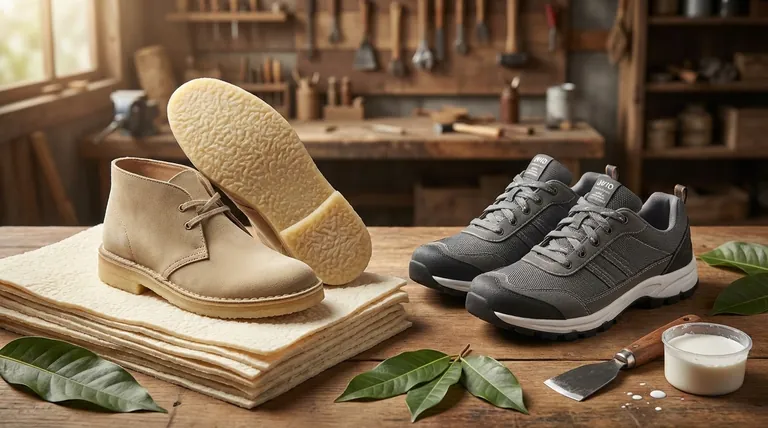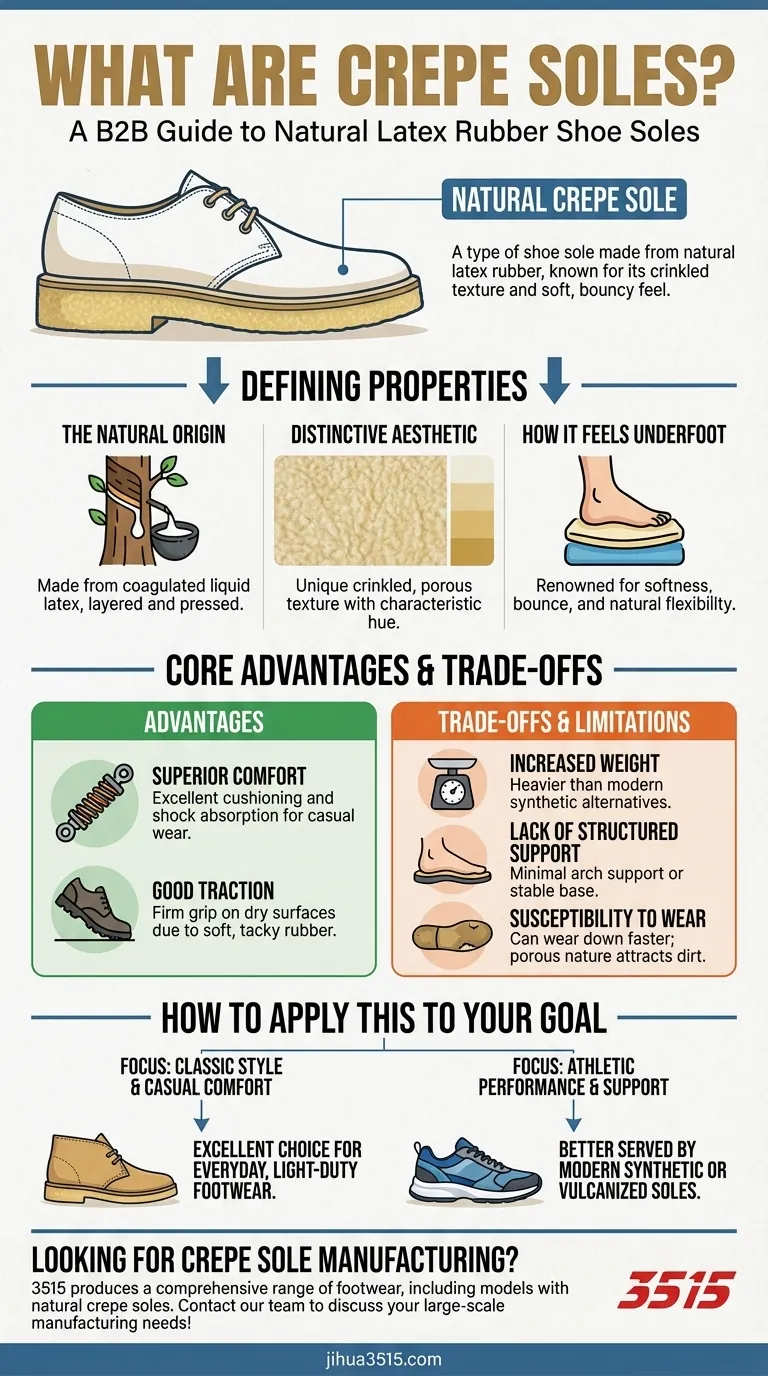In short, a crepe sole is a type of shoe sole made from natural latex rubber. It is known for its distinctive, crinkled texture and off-white or yellowish-brown color. Unlike highly processed synthetic materials, crepe rubber is created from sheets of coagulated latex, giving it a unique combination of softness, flexibility, and bounce.
Crepe soles offer a classic aesthetic and exceptional underfoot comfort due to their natural flexibility. However, this comes at the cost of increased weight, lower durability, and less support when compared to modern synthetic or vulcanized rubber soles.

What Defines a Crepe Sole?
Understanding the unique properties of crepe begins with its natural origin and minimal processing. This directly influences its look, feel, and performance.
The Natural Origin
A crepe sole is made from liquid latex tapped from rubber trees. This latex is coagulated into soft, gummy sheets that are layered and pressed together.
This process is much less intensive than that used for standard vulcanized rubber, leaving the material in a more raw, natural state.
The Distinctive Aesthetic
The most recognizable feature of a crepe sole is its crinkled, porous texture and its typical yellow-brown hue. This look is a direct result of the layered, unprocessed rubber sheets.
How It Feels Underfoot
Crepe is renowned for its softness and bounce. The natural elasticity of the rubber provides a cushioned, comfortable experience that is more flexible than the rigid base of many modern shoes.
The Core Advantages of Crepe
While less common today, crepe soles are chosen for specific benefits that synthetic materials often struggle to replicate perfectly.
Superior Comfort and Cushioning
The primary advantage is comfort. The natural springiness of the material absorbs shock effectively, making it a comfortable choice for casual walking.
Good Traction
Crepe soles provide a firm grip on many surfaces due to the soft, tacky nature of the rubber. This quality improves traction in dry conditions.
Understanding the Trade-offs and Limitations
The same natural properties that make crepe comfortable also introduce significant disadvantages, which is why its use has become more specialized.
Increased Weight
Crepe rubber is noticeably heavier than modern synthetic alternatives like polyurethane or EVA foam. This added weight makes it less suitable for performance-oriented athletic footwear.
Lack of Structured Support
The inherent flexibility of crepe means it offers very little arch support or a solid shoe base. Individuals needing stability may find this material inadequate.
Susceptibility to Wear and Tear
While robust, crepe is a soft material that can wear down more quickly than hard vulcanized rubber. Its porous nature can also attract dirt and become discolored over time.
How to Apply This to Your Goal
Choosing a shoe with a crepe sole depends entirely on balancing your need for comfort with your performance and durability requirements.
- If your primary focus is classic style and casual comfort: The unique aesthetic and cushioned feel of a crepe sole make it an excellent choice for everyday, light-duty footwear.
- If your primary focus is athletic performance, all-weather durability, or structured foot support: You will be better served by shoes with modern synthetic or vulcanized rubber soles.
Ultimately, a crepe sole is a purpose-driven choice that excels in comfort but compromises on the technical advantages of modern footwear.
Summary Table:
| Feature | Advantage | Limitation |
|---|---|---|
| Material | Natural latex rubber | Softer, less durable than synthetics |
| Comfort | Excellent cushioning and bounce | Limited arch support |
| Traction | Good grip on dry surfaces | Porous texture can attract dirt |
| Weight | N/A | Heavier than modern foam soles |
| Durability | N/A | Wears down faster than vulcanized rubber |
Looking to develop comfortable, classic footwear with crepe soles?
As a large-scale manufacturer, 3515 produces a comprehensive range of footwear for distributors, brand owners, and bulk clients. Our production capabilities encompass all types of shoes and boots, including models featuring natural crepe soles for superior comfort and timeless style.
Let us help you create the perfect product for your market. Contact our team today to discuss your manufacturing needs!
Visual Guide

Related Products
- Durable Rubber Sole Outdoor Shoes Wholesale & Custom Manufacturing
- Durable Canvas Work Shoes with Rubber Lug Sole | Wholesale Manufacturer
- Custom OEM Training Shoes Wholesale Manufacturer Durable & Breathable
- Safety Footwear Wholesale Manufacturer for Custom OEM/ODM Production
- Durable Waterproof Rain Boots | Custom Manufacturer for Wholesale & Brands
People Also Ask
- What are some alternatives to hunting boots? Hiking, Rubber & Tactical Boots Explained
- Why are vulcanized soles popular in urban fashion? Discover the Legacy of Authentic Street Style
- How does cushioning work in hiking shoes? The Science of Shock Absorption
- Why are rubber-soled shoes considered multi-weather footwear? Unlock All-Season Traction & Protection
- What were traditional shoe soles made from before rubber? The History of Leather Soles



















